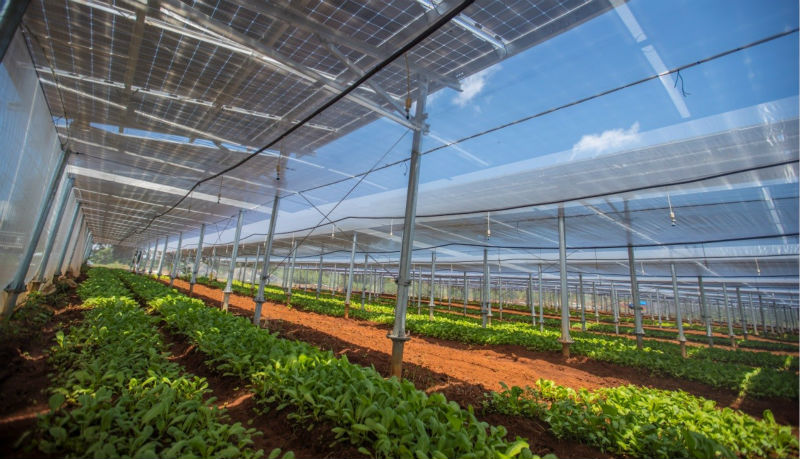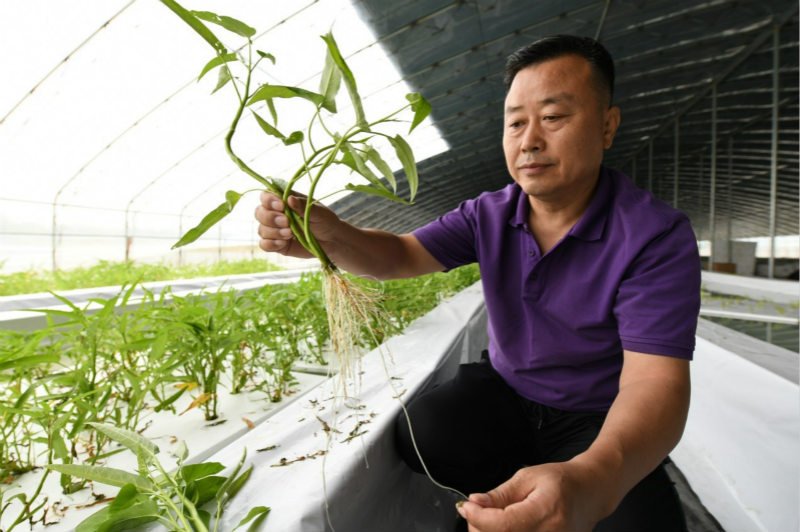

China’s annual vegetable production has been maintained at around 700 million tonnes during the 13th Five-Year Plan (2016-2020) period, and fruit production at around 180 million tonnes, said the country’s Ministry of Agriculture and Rural Affairs.
The acceptance rate of non-staple food supplies in the country’s regular monitoring was kept above 97 percent, according to the ministry. With more abundant varieties, higher qualities and smoother circulation, the Chinese people’s “vegetable baskets” are presenting them more sense of contentment.

A woman buys vegetables at a grocery shop in Shushan district, Hefei, east China’s Anhui province, Sept. 19. Photo by Ge Jun, People’s Daily Online
In a farm produce market in Hanjiang district, Wuhan, central China’s Hubei province, nearly hundreds of vegetables from across the country were put on the shelves, from local red spinach, Sichuan’s cabbages to small potatoes from Gansu. Cai Ping, a woman who went to grocery shopping at the market told People’s Daily that in the past people could only buy a few varieties, but now they have much more choices.
In Baituhe village of Pengzhou, Sichuan province, green vegetable shoots were thriving in standard greenhouses. “From seed selection and soil grading to management, we are supported by mechanization. Besides, we also adopted advanced technologies such as dryland raising and grafting to grow better vegetables,” said Chen Fengmao, head of an agricultural technology company. According to him, his company is able to produce over 50 million vegetable seedlings.
Pengzhou is home to nearly 55,000 hectares of vegetables, supplying more than 2 million tonnes of vegetables in 200 varieties to the whole country. It is a miniature of China’s large-scale, standardized and intensive production of vegetables.

A photovoltaic-vegetable project is put into operation in Fuchang village, Qiongshan district, Haikou, south China’s Hainan province, Aug. 24. Photo by Liu Yang, People’s Daily Online
According to statistics, China’s vegetable output hit 721 million tonnes last year, 5.2 percent higher than the average figure between 2015 and 2018. All 36 medium and large cities that have adopted the system of city mayors taking responsibility for the “vegetable basket” (non-grain food supply) program have established storage mechanisms for storable vegetables and meats. Thirty-three of them have established information monitoring and alarming system covering the whole industrial chain for vegetable, meat, fruit, egg, dairy and aquatic products.
At the entrance of Kunchen Xin’an farm produce market in Jianye district, Nanjing, east China’s Jiangsu province, stands a quick food testing center, where two screens are displaying all information about the quality and sources of agricultural products sold at the market. “The origin of every kind of vegetables and meat in the market can be traced,” said Chen Jianping, manager of the market, adding that they also launch regular sampling inspection over the products to ensure food safety.
During the 13th Five-Year Plan period, the quality and safety of China’s agricultural products generally maintained stable growth. The country now has 2,732 testing organizations that sampled and tested nearly 8 million items in the recent 5 years. China also carries out regular inspection for 111 kinds of daily agricultural products to test 130 of their indexes, 38 percent more than those in the 12th Five-Year Plan (2011-2015) period. Besides, the number of green food products, organic farm produces and geographical indications agricultural products totaled 48,000, up 63.9 percent from the 12th Five-Year Plan period.

A man checks the growth of water spinach in a fish-vegetable greenhouse in Jin’an village, Guangping county, Handan, north China’s Hebei province, Sept. 13. Photo by Cheng Xuehu, People’s Daily Online
In Shijingshan district of Beijing, all residents can place orders online on grocery shopping sites and get their orders delivered in 30 minutes. This is a result of the close cooperation between farmers and supermarkets, which enabled fresh fruits and vegetables to be put on the tables of consumers within 24 hours after being picked.
During the past 5 years, Chinese provinces and cities have made rational deployment of wholesale and retailing markets to ensure smooth circulation of non-staple food products. Xiamen, southeast China’s Fujian province established a three-level circulation network, with each residential community possessing over 20 outlets. Guangzhou of south China’s Guangdong province established 35 wholesale markets for non-staple food products that saw an annual transaction volume of 8.8 million tonnes. Now China is home to 4,100 wholesale farm produce markets, including 1,300 with an annual turnover above 100 million yuan ($14.73 million) each.

 Award-winning photos show poverty reduction achievements in NE China's Jilin province
Award-winning photos show poverty reduction achievements in NE China's Jilin province People dance to greet advent of New Year in Ameiqituo Town, Guizhou
People dance to greet advent of New Year in Ameiqituo Town, Guizhou Fire brigade in Shanghai holds group wedding
Fire brigade in Shanghai holds group wedding Tourists enjoy ice sculptures in Datan Town, north China
Tourists enjoy ice sculptures in Datan Town, north China Sunset scenery of Dayan Pagoda in Xi'an
Sunset scenery of Dayan Pagoda in Xi'an Tourists have fun at scenic spot in Nanlong Town, NW China
Tourists have fun at scenic spot in Nanlong Town, NW China Harbin attracts tourists by making best use of ice in winter
Harbin attracts tourists by making best use of ice in winter In pics: FIS Alpine Ski Women's World Cup Slalom
In pics: FIS Alpine Ski Women's World Cup Slalom Black-necked cranes rest at reservoir in Lhunzhub County, Lhasa
Black-necked cranes rest at reservoir in Lhunzhub County, Lhasa China's FAST telescope will be available to foreign scientists in April
China's FAST telescope will be available to foreign scientists in April